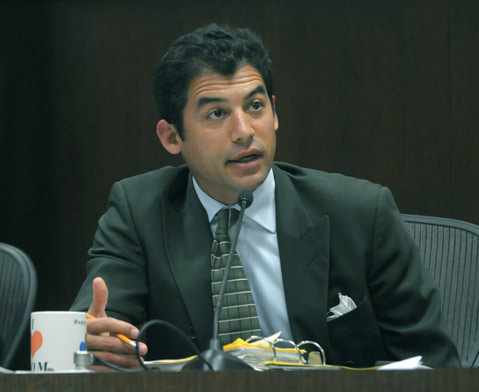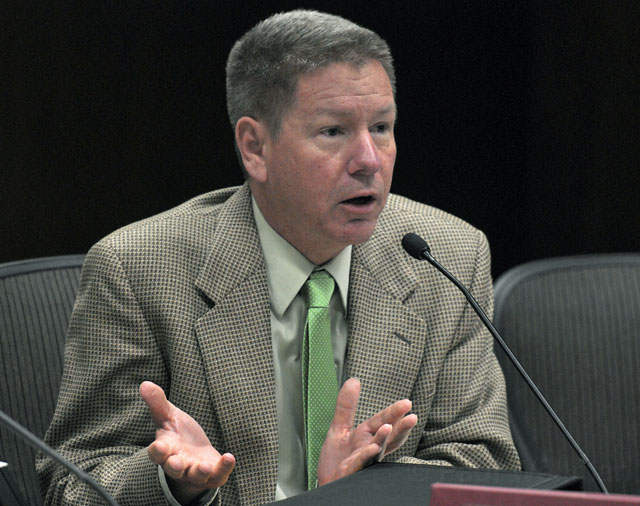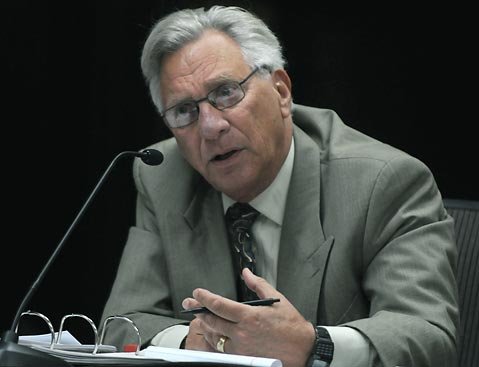Tempers Boil in Density Debate
General Plan Compromise Appears Dead on Arrival

It may be premature to declare efforts to update the City of Santa Barbara’s General Plan dead in the water, but after the explosive debate at this Friday’s council subcommittee hearing, it would take nothing less than cosmic mouth-to-mouth resuscitation to bring it back to life. There, last-ditch efforts to hammer out a compromise over what downtown housing densities would be allowed blew up into a surly, ideological, and personal exchange between Councilmembers Das Williams and Dale Francisco, who represent the yin and yang of the starkly split council where housing densities are concerned.
Both Williams and Francisco — often polar lightning rods during council deliberations — were patronizing, dismissive, and provocative at times. Williams walked out before the meeting was over. But given the radical differences between the two in terms of their visions of what Santa Barbara is and what it could be, as far as preservation of a viable middle class is concerned, it’s doubtful negotiations would have been fruitful even if the two council antagonists had been on their choir boy best behavior.
City Planning staff had hoped to put the city’s proposed new General Plan — the document guiding what kind of growth will be allowed, accommodated, and encouraged over the next 20 years — to a council vote this coming Tuesday. Not coincidentally, that happens to be Williams’ last day on the dais, his term being foreshortened one year since winning election as the region’s newest Assembly member.
Although Williams is part of a four-member majority that strongly supports increasing downtown residential densities as a strategy for expanding affordable housing opportunities for middle class workers, a five-vote super majority is required to get the new General Plan passed. Francisco — who heads the council minority concerned that increased downtown densities will increase crime rates and destroy Santa Barbara’s historic character — is regarded as the essential swing vote to get anything approved.

To that end, Williams and Francisco formed an ad hoc subcommittee three weeks ago — also joined by anti-density Councilmember Frank Hotchkiss — to see if any compromise was possible. Ironically, it was the initial progress of this subcommittee that inspired eight community groups — the so-called “smart-growthers’” versus traditional slow-growthers — that have been warring for 15 years over issues of affordability, height, density, and community character to see if they could find common ground. Astonishingly and historically, these groups did just that last week and announced their results to the City Council last Tuesday.
As practical matter, the impasse reached Friday between Williams and Francisco will effectively postpone any resolution of the General Plan — already five years and $3 million in the making — until after next November’s City Council elections, when these issues will likely emerge as defining campaign issues. (Anti-density Councilmembers Michael Self and Dale Francisco are up for reelection.) Indirectly, this impasse will also make it that much harder to find a replacement for Williams on the council. With the council split 3-3 after Williams’s departure, it’s increasingly unlikely any of the candidates —15 and rising — now seeking the council appointment can muster the four votes needed. Should no appointment be possible, the council will have to hobble through the next year with less than a full roster.
The Tide Turns Ugly
The fireworks started in earnest when Francisco expressed deep doubts that any new residential densities should be allowed downtown — as proposed in the draft General Plan update — to encourage the development of affordable housing. In the plan is a proposal that in certain downtown neighborhoods, developers would be allowed to build more units per acre than the zoning ordinance would normally allow, as long as those units were smaller in size. The smaller the units, the more could be built. (But no matter how many units were built, the overall maximum square footage would not budge.) Smaller units, the thinking goes, would be less expensive, hence more within the grasp of middle class workers. This new approach — known as average size zoning — stands in contrast to what’s on the books now, which calibrates allowable development according to the number of proposed bedrooms, no matter how big or small they might be. Because of this, existing zoning rules effectively encourage developers to maximize the size of their units, hence the proliferation of larger luxury condominiums.
While Francisco buys into “average size zoning” in concept, he balked at some of the maximum densities that under certain circumstances could be approved under the new General Plan. For example, if developers maxed out the number of smaller units buildable on an acre of land — and then took advantage of certain incentives suggested to encourage the development of rental housing — they could build up to 67 units per acre. That’s far more than Francisco and many others in the traditional slow-growth camp are comfortable with. But a majority of councilmembers, city staff, many in the development community, and affordable housing advocates insist such densities are absolutely crucial to making such projects economically viable. Furthermore, Williams argued that only by giving developers an incentive to construct higher density developments in certain downtown neighborhoods — along Haley and Cota streets for example — can they be lured away from developing smaller but more high-end projects in residential neighborhoods where land values are lower than in downtown.
With this having been discussed, Williams demanded of Francisco, “What’s the problem?” Francisco replied, “The problem is that we don’t want to an experiment on downtown Santa Barbara, which is the precious crown jewel.” Later on, he would add, “These are not Lego blocks. This is a real city with real people.”
Williams retorted, “What you seem to have the understanding gap on is that there is a real already. Our problem is that we’re expelling our young people to Oxnard and Lompoc and Santa Maria.” Without increasing densities, Williams argued, Santa Barbara would go the way of other wealthy enclaves, where the rich and poor increase in number, but the middle class shrinks into irrelevance. Then, a clearly frustrated Williams accused Francisco of bargaining in bad faith. “To me it is clear you have wasted this community’s time, that you had no intent in the first place of ever saying where you thought increased density was appropriate.”
Francisco has always been skeptical that market rate units — no matter how small — could fall within the economic grasp of most downtown workers. Santa Barbara has already done everything it could have done to promote affordable housing, he said; to do more is just not realistic. “I don’t believe you’re going to save the middle class, Das. This is a wealthy community for a reason. It’s irrational to try to build affordable housing in Beverly Hills, Venice, or in Santa Barbara. We’ve done the best we can. ”
Later, when Williams continued about the expulsion of the middle class, Francisco interrupted with a sarcastic, “Yea, yea, yea, the extinction of the middle class.”
Williams pointed out that if he managed to buy a 900-square-foot condo on an income of $55,000, then the task was not as impossible as Francisco contended. Francisco expressed skepticism that many people making $55,000 could hope to buy a condo in Santa Barbara. “I see no reason to experiment with our downtown,” he said. Williams countered that every major improvement in downtown over the past 30 years was the product of an experiment instigated by city hall. “Some of those experiments were good; some were terrible,” Francisco replied.

Frank Hotchkiss — an ally of Francisco’s — argued it was futile to even try to create a space for young Santa Barbarans making their way into the workforce. “The kids are not going to stick around in the old home town no matter how wonderful it is,” he said. “I just need to blow that concept out of the water.”
Williams accused Francisco of engaging in a “a charade,” meaning he never sincerely meant to find common ground. “Das, let us not descend into insults,” Francisco replied. “I have put at least as much time into this as you have, Das. This is not a charade. I am not getting emails from people saying, ‘Please, please, please increase density in Santa Barbara.’ I get emails from people saying just the opposite.” Francisco argued increased density would beget only increased traffic congestion and that would create problems for downtown businesses. Instead, he said he was committed to a platform of “easy parking, no vagrants, and no graffiti.”
Williams countered that congestion would be reduced by concentrating new development in certain downtown neighborhoods — where the infrastructure could handle it — rather than allowing it to sprawl throughout the metropolitan areas, further challenging intersections that are already struggling to maintain adequate service levels.
Francisco argued that the only affordable housing that can be realistically developed is rental housing. To that end, he said he supported increased densities for downtown rental projects.
Williams challenged Francisco to name one rental project built in Santa Barbara over the past 20 years. Francisco acknowledged he couldn’t name one. City planners have reported that no private developers have proposed rentals in any number since federal tax laws changed in 1986, effectively yanking the plug on the private rental market. “This is all speculative,” Williams said. “This is all hope. I’m not willing to leave the future of Santa Barbara dependent upon some hope.”
Francisco accused Williams of trying to rush the General Plan update through while he was still on the council. But the plan was more important than that, and he would not be rushed. Williams complained that he and the smart-growth councilmembers had compromised on a number of key items — agreeing to a de facto height restriction of 45 feet rather than the 60 feet now allowed for — and that Francisco’s camp hadn’t budged. “You are obstructing in order to get what you want,” replied Williams. “Two can play at that game.” Williams said voters would decide who was right come next November, when Francisco and his supporter Michael Self were up for reelection. “We can obstruct, too, and push it to 2012.”
On That Note …
Afterward, city planner Betty Wiess sought to salvage some shred of possibility out of the rhetorical crossfire between Williams and Francisco. After spending five grueling years on this effort, Weiss — who’s come in for criticism over the amount of time and money spent on the General Plan update process — queried Francisco to see if he could support the conceptual notion that there might be greater incentives given to developers to build rental housing in certain parts of the city as opposed to others. Francisco was noncommittal on that, prompting Williams to object that any further inquiry was fruitless. “You’re just negotiating against yourself,” he told Weiss. It was especially pointless, Williams said, “given how much I’ve given already,” referring to concessions about building heights and aggressive traffic control plans — no more free parking downtown — so controversial they were dead almost before they were hatched. “I wish you’d stop saying that,” shot back Francisco. “You haven’t given anything.”
The next installment of the struggle over the General Plan update is scheduled to take place Tuesday evening at 6 p.m. in the Santa Barbara City Council chambers.



